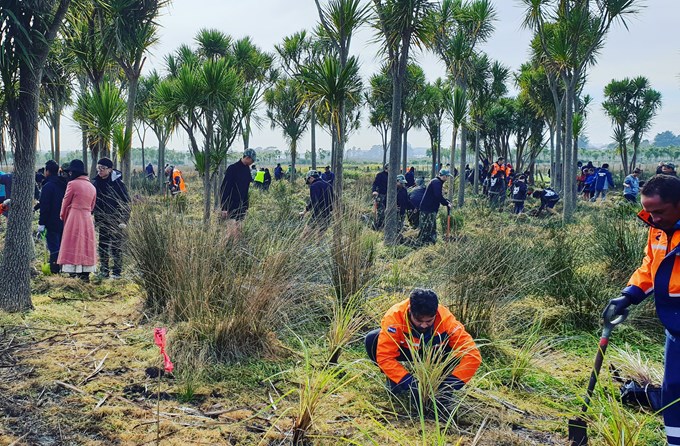Between 2013 and 2018 average urban ngahere (forest) canopy cover increased in Auckland by about 60 hectares, an area equivalent to around 60 sports fields.
“Healthy, flourishing forest canopies are the lungs of our city,” says Auckland Councillor and Environment and Climate Change Committee Chair Richard Hills.
“New data shows we have maintained the overall size of our forest canopy across urban Auckland and are even seeing healthy new growth on public land. It’s so exciting to see the hard work start to show up in the data," says Councillor Hills.
The data comes from a report commissioned as part of the council’s Urban Ngahere Strategy, which aims to increase ngahere canopy coverage to 30 per cent across urban Auckland.
“Unfortunately, changes to the Resource Management Act have meant a really difficult few years for Auckland’s environment as the removal of a blanket tree protection led to ongoing losses of mature trees across the city and particularly on privately-owned property,” adds Councillor Hills.
“Inequities remain. There are areas in Auckland where tree cover is far lower than others and well below our targets. Addressing this inequity is a real priority for us.
“I want children across Auckland, no matter the suburb, to be able to walk home from school sheltered from the sun,” he adds, “it takes years to see the trees planted grow large enough to show up in our data. What we prioritise now will have an impact well into the future.”
Deputy Chair Councillor Pippa Coom agrees, emphasising the role of volunteers and community groups in helping grow the city’s ngahere.
“Community involvement is vital in growing and caring for trees – as we’re seeing in places like Totara Park and Puhinui Reserve – and through groups like the Kaipatiki Project. Our community want to see an increase in tree cover and have made an enormous difference through planting, ecological improvement and pest control," she says.
“We really need to acknowledge their efforts and thank them for both their advocacy and work on and in the ground. It’s encouraging to see our urban forest cover maintaining and even beginning to grow again as it is a real priority for the council and for Auckland.”
Benchmarking Auckland's urban forests
Next week the council will present to the Environment and Climate Change Committee an update on the Urban Ngahere Strategy’s progress since launching last year.
Auckland Council Head of Parks Services, Mark Bowater, explains that alongside new planting initiatives one of the first projects underway is to benchmark the state and size of Auckland’s tree canopies. This will help inform future work.
“We have embarked on a series of research initiatives and our first snapshot report shows no loss to the overall size of Auckland’s urban forests," says Mr Bowater.
“Between 2013 and 2016-2018 when the survey was conducted tree canopy gains balanced out overall losses and there was a slight positive net growth across the city, which indicates the council is holding its own on public land.
“These results are promising for Auckland but there is much more work ahead if we are to keep making a positive trajectory on growing the scale of our urban forests – and to help offset loss of mature trees.”
Survey gives a treetop view
The survey showed average tree canopy coverage across the city in 2016-2018 was 18.4 per cent; similar to the 2013 baseline average cover of 18.3 per cent but well below the 30 per cent long term goal for the city identified in the Urban Ngahere Strategy
At a local board level, average canopy cover ranged from 8 per cent to 31 per cent. The Kaipatiki and Upper Harbour local boards had the highest average cover (respectively 31 per cent and 28 per cent) and Māngere-Ōtāhuhu and Ōtara-Papatoetoe local boards the lowest (respectively 8 per cent and 9 per cent).
The results also indicate that increases in canopy coverage are mainly across public land and road corridors while losses are widespread - the majority of removals has taken place on privately-owned property.
Mr Bowater says the council is addressing the results by focusing efforts on areas that need the most; south Auckland is one of the key areas identified in the strategy and the latest survey as having consistently low tree canopy cover.
It’s a balance of looking at what’s needed across the city, he adds: “Development is ongoing across the city so into the future public parks and open spaces are only going to become more important to us. The planting that we’ve put into Totara Park, for example, is turning retired farmland into an ecological area of high value for communities and the environment.”

Continuing to grow our urban forests
“Everybody can do their bit to help protect and grow trees in Auckland and be a good environmental steward for the city,” says Councillor Hills.
“It’s really heartening to see so many people getting involved with planting initiatives – community and business involvements like this are at the heart of what it takes to make positive changes to our environment and for the good of our climate.
“We also encourage Aucklanders to do their bit in their back yard by planting the right trees in the right place and considering small native trees as an option that would in time encourage more biodiversity in their gardens.”
Adds Mr Bowater: “Like any maintenance project requiring skilled tradespeople, we encourage Aucklanders to seek professional advice from qualified arborists when looking for information about the care of trees on their property, noting there are usually a range of management options to enable the retention of some trees on private property.”
Read the full Urban Ngahere committee report and the council's latest tree canopy coverage report.


